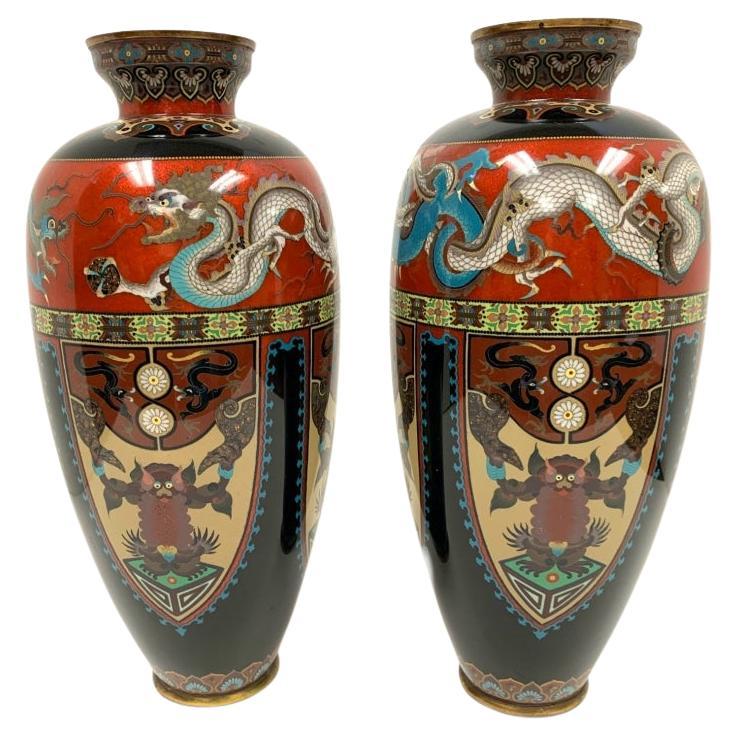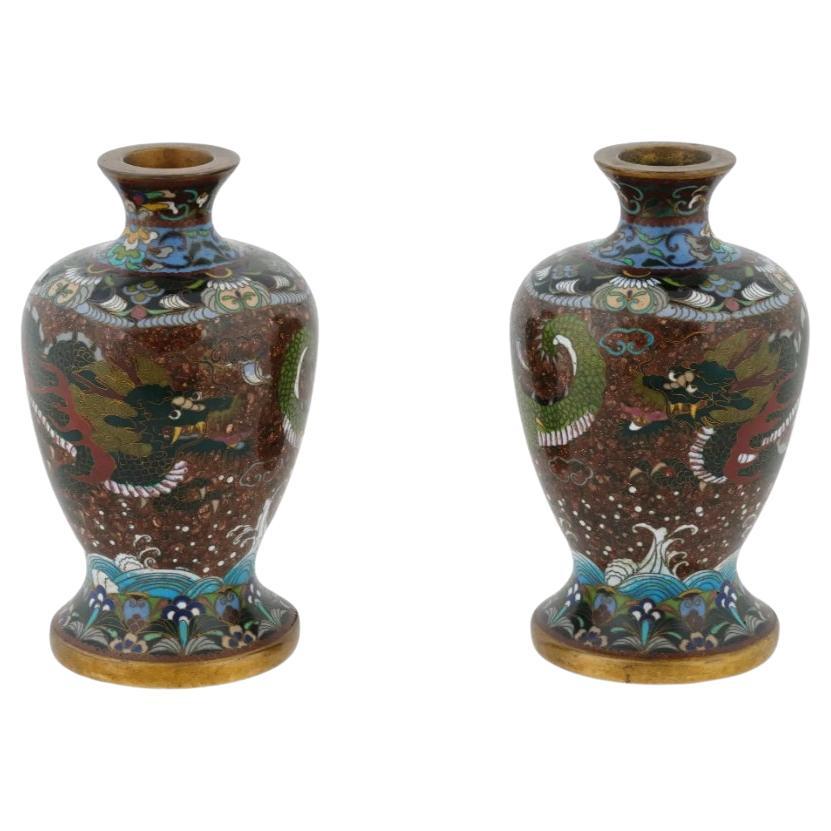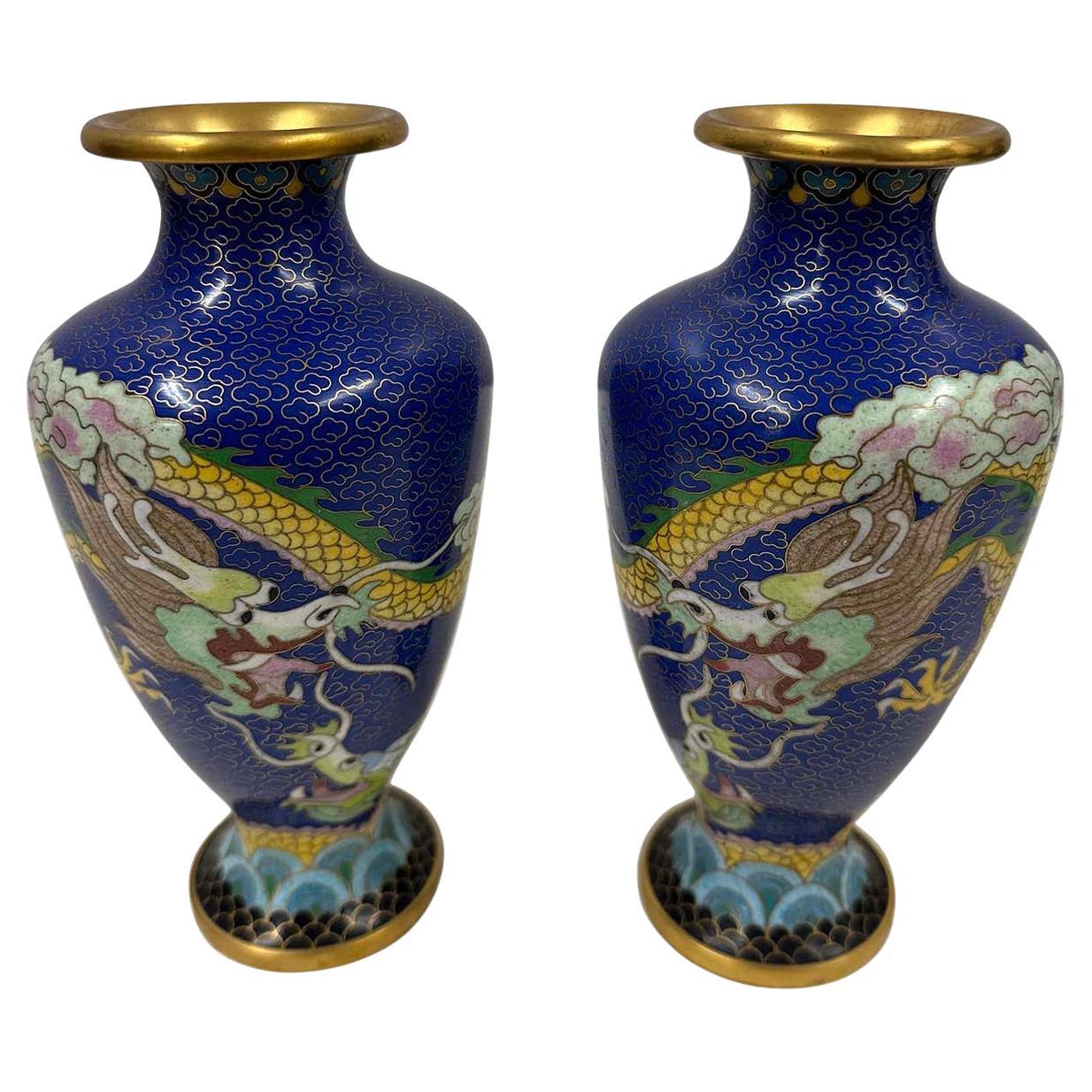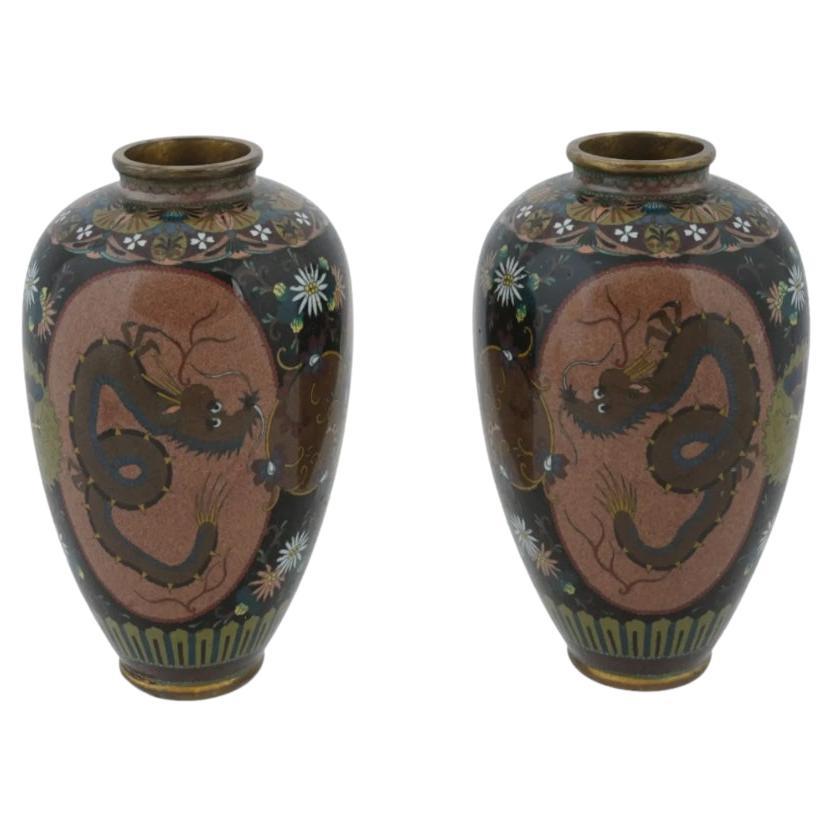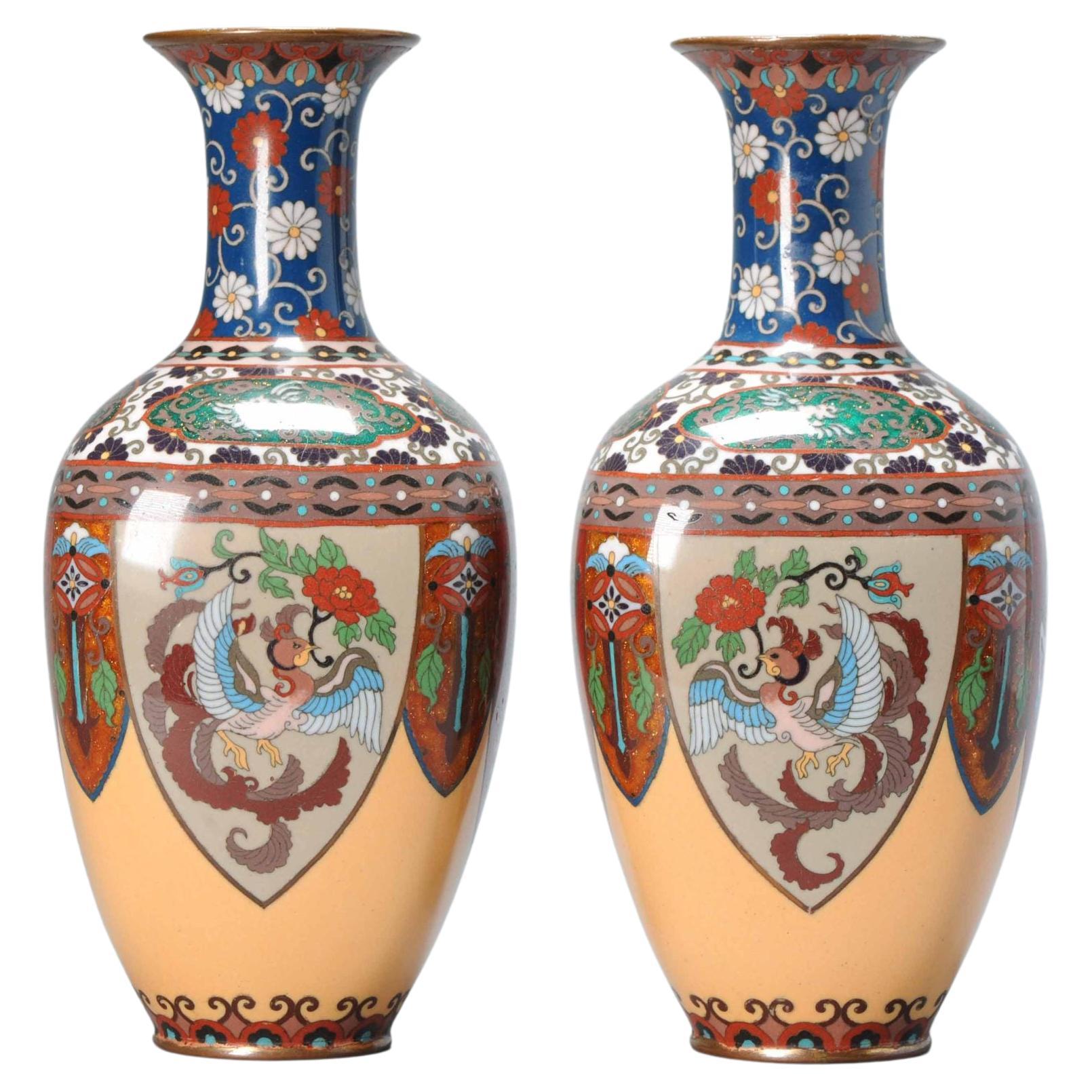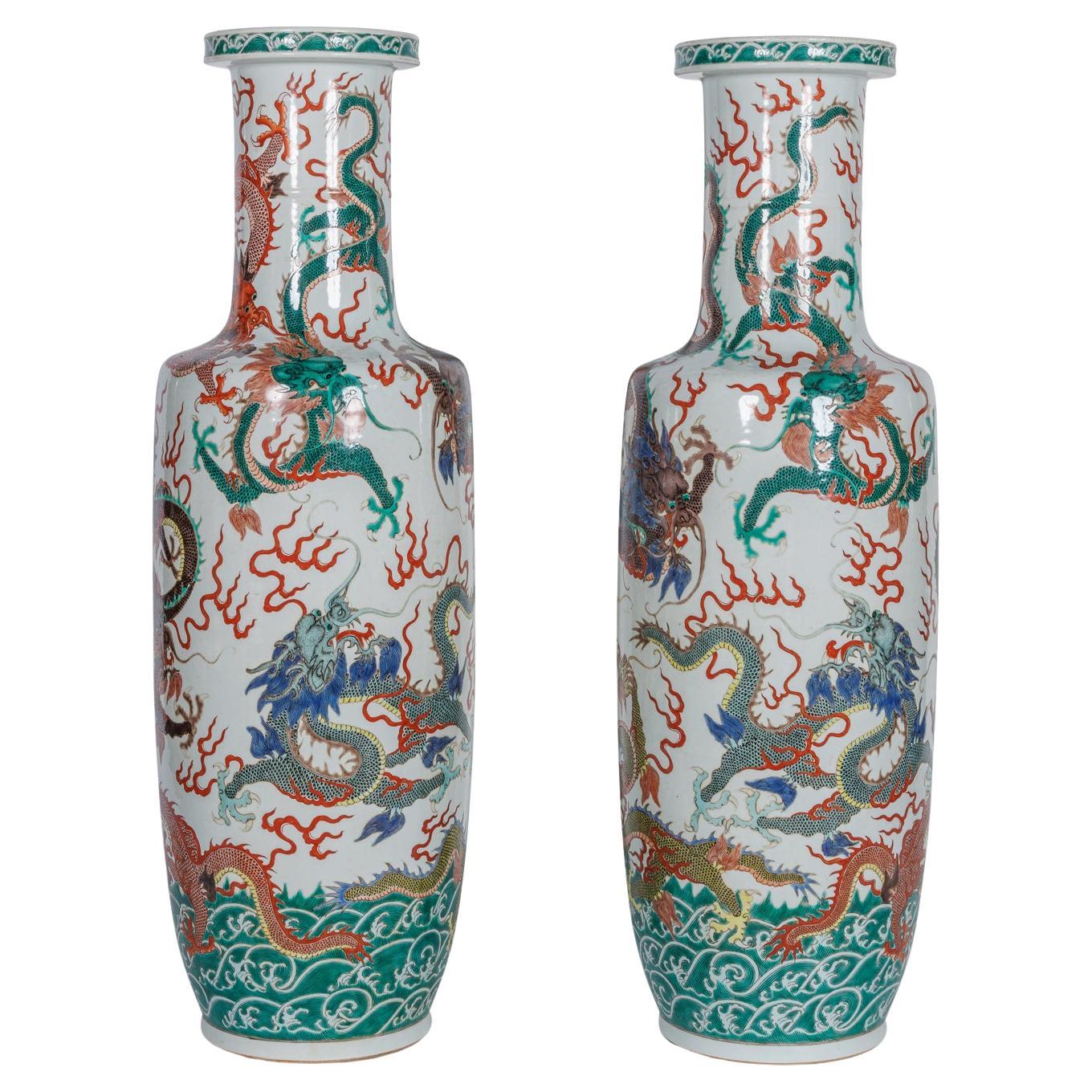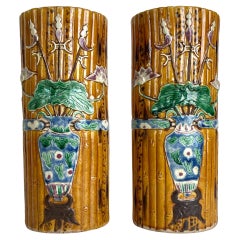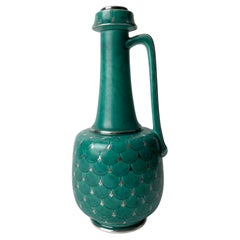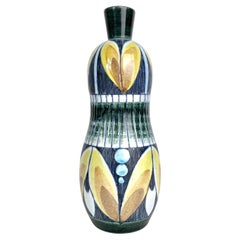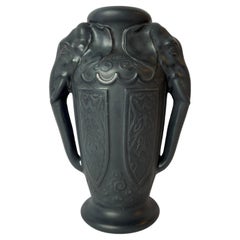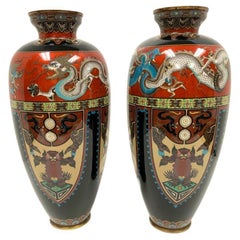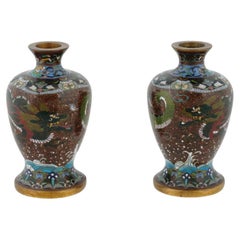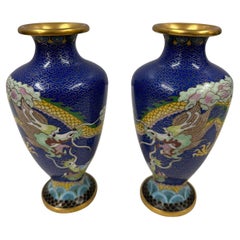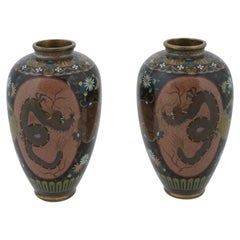Items Similar to Set of Two Japanese Cloissoné Vases Meiji Era Dragon and Pheonix
Want more images or videos?
Request additional images or videos from the seller
1 of 12
Set of Two Japanese Cloissoné Vases Meiji Era Dragon and Pheonix
$1,317.51per set
£976.35per set
€1,100per set
CA$1,798.66per set
A$2,000.93per set
CHF 1,048.91per set
MX$24,450.90per set
NOK 13,356.61per set
SEK 12,573.40per set
DKK 8,375.30per set
Shipping
Retrieving quote...The 1stDibs Promise:
Authenticity Guarantee,
Money-Back Guarantee,
24-Hour Cancellation
About the Item
A pair of Japanese cloisonné enamel vases. Meiji era Japan (1867-1912), a period marked by rapid transformation of Japanese traditional society into a global power. The period of growth was preceded by an era of isolation, with Japan to a large extent being closed to Western trade. The Meiji era saw a boom in diplomatic, technological and commercial ties to the industrial West, resulting in the flourishing of both new and traditional forms of artistic expression and craftsmanship. These vases feature several decorative patterns, including floral patterns and Seigaiha (traditional Japanese wave patterns).
The vases feature two mythical creatures, the Hou-ou (which has close parallells with the Chinese Fenghuang and is sometimes called the Japanese Pheonix) and a dragon. These creatures, when represented together, generally symbolize the joining and harmony between the male and female (dragon and Phoenix respectively). They also represent Celestial and Imperial authority, as well as the wedding bliss of the Emperor och Empress, as they do in China.
Wear consistent with age and use.
- Dimensions:Height: 9.45 in (24 cm)Diameter: 4.34 in (11 cm)
- Sold As:Set of 2
- Style:Meiji (Of the Period)
- Materials and Techniques:Enamel,Cloissoné
- Place of Origin:
- Period:
- Date of Manufacture:Meiji Era
- Condition:Wear consistent with age and use.
- Seller Location:Knivsta, SE
- Reference Number:1stDibs: LU7571235194082
About the Seller
5.0
Platinum Seller
Premium sellers with a 4.7+ rating and 24-hour response times
Established in 1996
1stDibs seller since 2022
97 sales on 1stDibs
Typical response time: <1 hour
- ShippingRetrieving quote...Shipping from: Knivsta, Sweden
- Return Policy
Authenticity Guarantee
In the unlikely event there’s an issue with an item’s authenticity, contact us within 1 year for a full refund. DetailsMoney-Back Guarantee
If your item is not as described, is damaged in transit, or does not arrive, contact us within 7 days for a full refund. Details24-Hour Cancellation
You have a 24-hour grace period in which to reconsider your purchase, with no questions asked.Vetted Professional Sellers
Our world-class sellers must adhere to strict standards for service and quality, maintaining the integrity of our listings.Price-Match Guarantee
If you find that a seller listed the same item for a lower price elsewhere, we’ll match it.Trusted Global Delivery
Our best-in-class carrier network provides specialized shipping options worldwide, including custom delivery.More From This Seller
View AllA pair of faux bamboo vases in porcelain. Chinese, late 19th Century
Located in Knivsta, SE
A pair of faux bamboo vases in porcelain. Made in China during the late 19th Century.
Very charming with beautiful colors.
Wear consistent with age and use
Category
Antique Late 19th Century Chinese Vases
Materials
Porcelain
Swedish Grace Ceramic Handle Vase, Argenta designed by Wilhelm Kåge 1930s-1940s
By Wilhelm Kage
Located in Knivsta, SE
Swedish Grace Ceramic Handle Vase, Argenta collection from the prominent Swedish Gustavsberg company, 1930s-1940s Sweden
This beautiful Swedish Grace vase in turquoise ceramics...
Category
Vintage 1930s Swedish Art Deco Vases
Materials
Ceramic
Decorative Vase from Tilgmans, Sweden with a very period design from the 1950s
By Tilgmans Keramik
Located in Knivsta, SE
Very Decorative Vase in cerramics from Tilgmans Keramik, Gothenburg, Sweden with a very period design from the 1950s. Made with Sgraffito technique.
Wear consistent with age and use
Category
Vintage 1950s Swedish Mid-Century Modern Vases
Materials
Ceramic
Beautiful Lavanite Vase Decorated with Elephants, Art Nouveau, circa 1910
Located in Knivsta, SE
A rare and beautiful Lavanite vase decorated with Elephants. Art Nouveau circa 1910. Probably made by W. Henker & Co in Berlin during the 1910s. Marked Lavanit Patent under the vase....
Category
Vintage 1910s German Art Nouveau Vases
Materials
Cast Stone
Beautiful ceramic Vase by Carl-Harry Stålhane, Sweden from the Mid-20th Century
By Carl-Harry Stålhane
Located in Knivsta, SE
Beautiful ceramic Vase by Carl-Harry Stålhane (1920-1990), Rörstrands Porslinsfabrik, Sweden from the Mid-20th Century. Decorated with two different women carrying bowls of fruit on ...
Category
Mid-20th Century Swedish Mid-Century Modern Vases
Materials
Ceramic
Beautiful pair of Empire Table Lamps, originally candlesticks from the 1820s
Located in Knivsta, SE
Beautiful pair of Empire Table Lamps in Bronze. Originally a pair of Empire candlesticks from the 1820s, converted to table lamps in the early 20th Century.
Newly rewired electrici...
Category
Antique 1820s French Empire Table Lamps
Materials
Bronze
$2,275 / set
Free Shipping
You May Also Like
Pair Of Japanese Meiji Era Cloisonne Vases
Located in Bridgeport, CT
Pair of Japanese cloisonné vases with fine traditional form decorated with dragons and demons, geometric motifs and floral bands.
Dimensions: 5" W x 12" H
Condition: Please see detai...
Category
Antique Late 19th Century Japanese Meiji Metalwork
Materials
Metal, Enamel
$1,400 / set
Antique Pair of Meiji Japanese Cloisonne Enamel Goldstone Dragon Vases
Located in Long Island City, NY
A pair of identical antique Japanese copper vases with cloisonne enamel design. Late Meiji period, circa 1885. Baluster shape, solid base, pronounced neck. Golden stone flake ground,...
Category
Antique 19th Century Japanese Meiji Vases
Materials
Copper, Enamel
Pair of Antique Chinese Cloisonne Dragon Vases
Located in Pomona, CA
This magnificent pair of Chinese Antique Cloisonné Vases is the perfect decor pieces. With beautiful two dragons playing design, it is a majest...
Category
Early 20th Century Chinese Chinese Export Vases
Materials
Metal, Copper
Antique Pair Early Meiji Japanese Cloisonne Enamel Dragon Crane Vases Attributed
Located in Long Island City, NY
Antique Pair Early Meiji Japanese Cloisonne Enamel Dragon Crane Vases Attributed to Honda
The exteriors of the wares are adorned with polychrome enamel medallions representing drago...
Category
Antique 19th Century Japanese Meiji Vases
Materials
Enamel
Pair of Round Cloisonné Enamel Vases Meiji Era '1868-1912' Dragons
Located in Amsterdam, Noord Holland
Top quality
Meiji era (1868-1912), 19th century
Each vase worked in gilt and wire of varying gauge with a mirrored design.
Condition
Vase one with some missing enamel/glaze spo...
Category
Antique 19th Century Japanese Qing Ceramics
Materials
Porcelain
$1,628 Sale Price
20% Off
A Highly Rare Pair of Monumental Qing Dynasty Rouleau Porcelain "Dragon" Vases
Located in Queens, NY
A Highly Rare Pair of Monumental Qing Dynasty Rouleau Porcelain "Dragon" Vases
A Masterful Display of 19th Century Chinese Artistry:
The mid-19th century Qing Dynasty marked a period of artistic innovation and imperial grandeur, as exemplified by this rare and monumental pair of Rouleau vases. These exceptional porcelain works, notable for their commanding size and vibrant palette, are a testament to the unparalleled craftsmanship that flourished during this era. Embellished with a dynamic tableau of dragons rendered in bold hues of red, green, blue, brown, and yellow, these vases embody both artistic brilliance and the deep cultural symbolism woven into Chinese decorative arts.
Artistic Excellence and Symbolism:
At the heart of these magnificent vases lies a visual narrative that channels the power and mystique of the dragon, a central motif in Chinese culture symbolizing imperial authority, strength, and cosmic energy. The intricate depiction of dragons in motion, intertwined amidst stylized ocean waves, conveys a sense of fluidity and dynamic movement. Each color used—the crimson reds, verdant greens, striking blues, earthy browns, and golden yellows—has been meticulously applied, reflecting a mastery of the high-fired, polychrome enameling techniques perfected during the Qing Dynasty.
The Rouleau form, with its cylindrical body, short neck, and slightly flared mouth, was a favored shape for large-scale vases in the 18th and 19th centuries. The form’s structured elegance allowed for expansive decorative panels, serving as an ideal canvas for intricate, multi-layered designs. This pair demonstrates how artisans skillfully balanced the flowing movement of the dragons with the rhythmic motifs of waves, resulting in a harmonious composition that engages the viewer from every angle.
Craftsmanship and Technique:
These vases represent the pinnacle of porcelain artistry achieved under the Qing Dynasty, showcasing techniques that reflect centuries of refined craftsmanship. The precision in the application of overglaze enamels and the expert manipulation of kiln temperatures to achieve vibrant and consistent coloration are indicative of the expertise within the imperial kilns. The dragons' scales, rendered with remarkable detail, create a textured effect that contrasts beautifully with the smooth, undulating waves, enhancing the three-dimensional quality of the design.
The depth of color and the crisp delineation of each element point to a rigorous and time-intensive process. These qualities signify the involvement of highly skilled artisans who adhered to the imperial standards set by the royal court, ensuring that each piece was a fitting representation of the empire’s wealth and cultural prowess.
Historical and Cultural Significance:
Vases of this caliber were not merely decorative; they were imbued with profound symbolic meaning and often commissioned for imperial use or gifted as prestigious diplomatic offerings. The dragon motif, deeply embedded in Chinese folklore and philosophy, was associated with the emperor himself—known as the "Son of Heaven"—and symbolized his divine right to rule. These vases also reflect the Qing Dynasty's flourishing export trade and the global fascination with Chinese porcelain during the 19th century. European collectors and royal patrons prized such pieces for their artistry and the exoticism they represented, contributing to a legacy that elevated Chinese porcelain to a revered status in the annals of decorative art history.
Provenance and Collectability:
The extraordinary scale, exceptional craftsmanship, and rarity of this pair establish them as museum-quality works. Such vases would have held a place of honor in a palace or wealthy estate, reflecting not only the owner’s status but also an appreciation for the profound cultural and artistic traditions of China. Their provenance—potentially tied to an imperial commission or significant historical collection—underscores their importance as objects of study and admiration.
Provenance:
Private American Collection, acquired in London, circa 1905.
Thence by descent to the current owners
Solomon Treasure...
Category
Antique Mid-19th Century Chinese Qing Ceramics
Materials
Porcelain
More Ways To Browse
Emperor Japan
Japanese Dragon
Antique Japanese Dragon
Japanese China Set
Meiji Dragon
Emperor And Empress
Dragon And Phoenix
Black Dragon Vase
Meiji Dragon Vase
Chinese Dragon And Phoenix
Phoenix Chinese Vase
Emperor Empress Art
Cloisonne Dragon Vase
Japanese Cloisonne Dragon
Meiji Cloisonne Dragon
Empress China
Chinese Cloisonne Dragon
Chinese Vases Dragon Cloisonne
